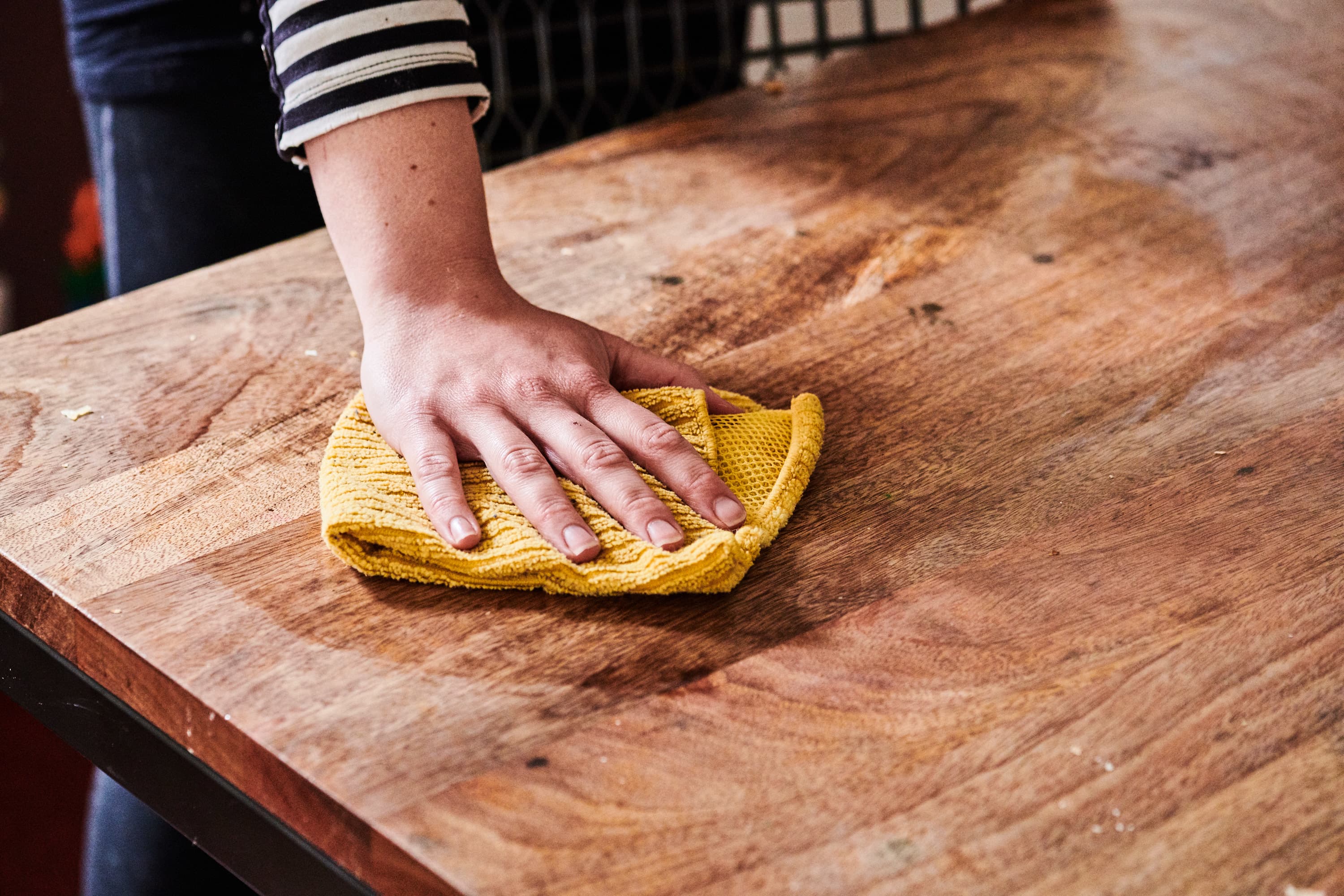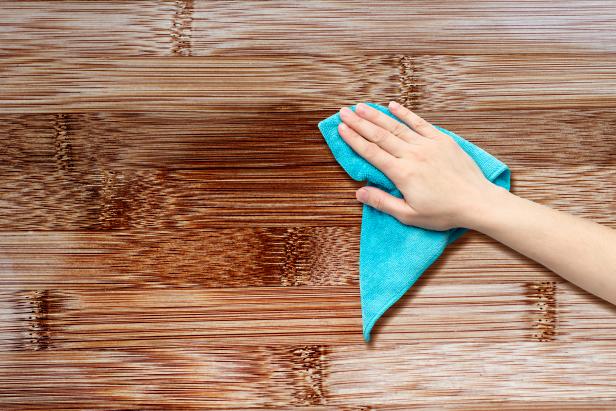Are you tired of seeing your once beautiful wood table covered in dust, stains, and grime? Don’t worry, because I’m here to help you bring back its natural shine and elegance. Cleaning a wood table may seem like a daunting task, but with the right techniques and a little bit of effort, you can easily restore its beauty and make it the centerpiece of your home once again.
In this comprehensive guide, I will walk you through the step-by-step process of cleaning a wood table effectively and safely. Whether you have a vintage heirloom, a modern dining table, or a rustic coffee table, these techniques are suitable for all types of wood surfaces. From removing stubborn stains to polishing the surface to a brilliant shine, you’ll learn everything you need to know to make your wood table look as good as new. So, roll up your sleeves, grab your cleaning supplies, and let’s dive into the world of wood table cleaning together!
How to Clean Wood Table:
- Remove any loose debris from the table surface using a soft brush or cloth.
- Mix a mild solution of dish soap and warm water in a bucket.
- Dip a clean cloth or sponge into the soapy water and wring out excess liquid.
- Gently wipe the table surface in the direction of the wood grain, being careful not to saturate the wood.
- Rinse the cloth or sponge and wipe down the table again to remove any soap residue.
- Dry the table thoroughly with a clean, dry cloth.

How to Clean a Wood Table
Wood tables are a beautiful addition to any home, but they can easily become dirty and stained over time. Proper cleaning and maintenance are essential to keep your wood table looking its best. In this article, we will provide you with a step-by-step guide on how to clean a wood table effectively.
Gather the Necessary Supplies
Before you begin cleaning your wood table, it’s important to gather all the necessary supplies. This will ensure that you have everything you need within reach and can complete the cleaning process efficiently. Here are the supplies you will need:
- Mild dish soap
- Warm water
- Soft microfiber cloth
- White vinegar
- Olive oil or wood polish
- Soft-bristled brush
Remove Dust and Debris
The first step in cleaning a wood table is to remove any dust and debris that may have accumulated on the surface. Start by using a soft microfiber cloth to gently wipe the table, removing loose dirt and particles. Avoid using abrasive materials or harsh chemicals, as these can damage the wood’s finish.
If there are stubborn areas with stuck-on dirt or grime, dampen the cloth with a mixture of mild dish soap and warm water. Gently scrub the affected areas in a circular motion until the dirt is loosened. Be careful not to apply too much pressure, as this can cause scratches.
Deal with Stains
If your wood table has any stains, it’s important to address them before proceeding with the general cleaning. One effective method for removing stains is using a mixture of white vinegar and warm water. Dampen a soft cloth with the vinegar solution and gently rub the stained area. Rinse the cloth with clean water and continue until the stain is lifted.
For tougher stains, you can create a paste using baking soda and water. Apply the paste to the stained area and let it sit for a few minutes before gently scrubbing with a soft-bristled brush. Rinse the area with clean water and dry thoroughly.
Apply Wood Polish or Olive Oil
Once your wood table is clean and free from stains, it’s time to restore its shine and protect it from future damage. You can use either wood polish or olive oil for this purpose. Apply a small amount of the chosen product onto a clean, soft cloth and gently rub it onto the table’s surface in the direction of the wood grain. This will help moisturize the wood and give it a beautiful, lustrous finish.
After applying the wood polish or olive oil, allow it to sit for a few minutes, and then buff the table with a clean cloth to remove any excess product. This step will help ensure an even finish and prevent any sticky residue.
Maintain Regular Cleaning Routine
To keep your wood table looking its best, it’s important to maintain a regular cleaning routine. Dust the table frequently using a soft cloth or a feather duster to prevent the build-up of dirt and debris. Additionally, avoid placing hot or wet items directly onto the table’s surface, as this can cause damage.
By following these simple steps and maintaining a regular cleaning routine, you can keep your wood table looking beautiful and extend its lifespan.
Frequently Asked Questions
Here are some common questions about how to clean a wood table:
Q: What is the best way to clean a wood table?
The best way to clean a wood table is to start by removing any dust or debris using a soft cloth or a microfiber duster. Next, mix a solution of mild dish soap and warm water. Dampen a clean cloth in the solution, wring it out well, and gently wipe the table surface in the direction of the wood grain. Avoid using excessive water as it can damage the wood. Finally, wipe the table dry with a clean, lint-free cloth.
It’s important to note that different types of wood may require specific care instructions. Always refer to the manufacturer’s guidelines or consult a professional for advice on the best cleaning method for your specific wood table.
Q: How often should I clean my wood table?
The frequency of cleaning your wood table depends on its usage and the level of dirt and spills it encounters. As a general guideline, it is recommended to dust the table regularly with a soft cloth or a microfiber duster to prevent the accumulation of dust. A deep cleaning with a mild soap solution can be done every few months or as needed. However, if you notice any spills or stains, it’s best to clean them immediately to prevent them from becoming permanent.
Remember to always check the manufacturer’s recommendations for cleaning frequency, as some wood tables may require more or less frequent cleaning depending on the type of finish or treatment they have received.
Q: Can I use furniture polish on a wood table?
Using furniture polish on a wood table is generally not recommended, especially if the table has a protective finish or coating. Furniture polish can leave a residue on the surface of the table, making it look dull and attracting more dust and dirt. It can also lead to a buildup of product over time, which can be difficult to remove.
If you feel that your wood table needs some extra shine, opt for a high-quality wood conditioner or a specially formulated wood polish that is suitable for your table’s finish. Always read the instructions and test the product on a small, inconspicuous area before applying it to the entire table.
Q: How do I remove stains from a wood table?
To remove stains from a wood table, start by identifying the type of stain. For watermarks, gently rub the affected area with a cloth dampened in a mixture of equal parts vinegar and olive oil. For ink or food stains, make a paste using baking soda and water, apply it to the stain, and let it sit for a few minutes before wiping it off with a damp cloth.
For more stubborn stains, you can try using a commercial wood stain remover following the product instructions. However, be cautious and test the product on a small, inconspicuous area first to ensure it does not damage the wood or its finish. If the stain persists, it may be best to seek professional help to avoid causing further damage to the wood.
Q: How can I protect my wood table from scratches?
To protect your wood table from scratches, always use coasters, placemats, or tablecloths to prevent direct contact with hot dishes, cold beverages, or sharp objects. Avoid dragging heavy or rough items across the table surface, as this can leave scratches.
If your table has a protective finish, you can also consider applying a furniture wax or polish that contains a protective layer to help minimize scratches. Regularly inspect your table for any signs of wear or damage, and address them promptly to prevent further deterioration.

Remember, always start by dusting the table with a soft cloth or feather duster to remove any loose debris. Then, use a mild wood cleaner or a solution of vinegar and water to gently clean the surface. Avoid using harsh chemicals or abrasive materials, as these can damage the wood. Lastly, don’t forget to regularly apply a protective finish, such as wax or oil, to keep the wood moisturized and protected from spills and stains. By taking these simple steps, you can maintain the natural beauty of your wood table and enjoy its timeless appeal for generations.
- How to Design Wood Carving - May 7, 2024
- How to Carve Wood - May 7, 2024
- How to Remove Cat Urine From Wood Furniture - May 7, 2024